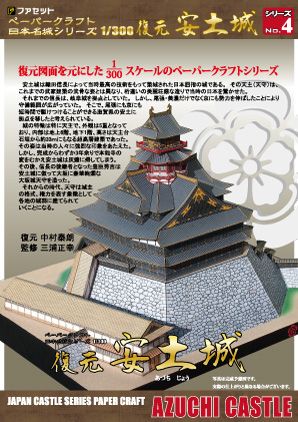Azuchi Castle
Scale: 1/300
Skill Level: medium
Size (LxWxH): 165x180x170 mm (6x7x6 inch)
Azuchi Castle, a legendary fortress constructed by Oda Nobunaga, was tragically destroyed a mere three years before the infamous Honnoji Incident. Despite its short existence, the grandeur and opulence of the castle tower, believed to be Japan's first of its kind, offer insight into the immense power and distinctive personality of Oda Nobunaga. This model, designed by one of Japan's most famous designers - Shigeru Ishihara, reflects a little bit of its grandeur.
| Product type | Papermodel |
|---|---|
| Manufacturer | Facet |
| Scale | 1/300 |
| Designer | Shigeru Ishihara |
| Difficulty | medium |
| Sheet size | DIN A4 |
| Sheets | 5 |
| Parts | 59 |
| Length | 165 mm (6.5 inch) |
| Width | 180 mm (7.09 inch) |
| Height | 170 mm (6.69 inch) |
| Bauanleitung | Pictures |
Azuchi Castle was distinguished by its construction of entirely stone walls and the innovative addition of a large castle tower featuring five above-ground floors, six floors, and one below-ground floor, a pioneering design for its time. This architectural marvel set a precedent for future castle designs across Japan until the early Edo period. Situated along the Azuchiyama mountain range bordering Lake Biwa, the castle boasted a strategic location with easy access to Kyoto, Lake Biwa's waterways, and the Hokuriku Highway. Stone-walled residences for vassals lined the southern foot of the mountain, while atop the peak stood the imposing structures of Honmaru Palace and Ninomaru Palace, alongside the residence of Nobunaga himself.
Construction of Azuchi Castle commenced in 1576, and three years later, in 1579, Nobunaga took up residence in the completed castle tower. Tragically, just three years after its completion, the castle fell victim to a devastating fire during the Honnoji Incident in 1582, resulting in the loss of its iconic tower and main enclosure. Despite this setback, the castle remained functional for a time, primarily centered around the Ninomaru.
In 1585, the castle was abandoned to make way for the construction of Hachimanyama Castle by Toyotomi Hidetsugu, Hideyoshi's adopted son. Recent excavation research and meticulous maintenance efforts have now restored key features such as the grand main road, tiger entrance, and formidable stone walls, offering visitors a captivating glimpse into history.


 Deutsch
Deutsch





